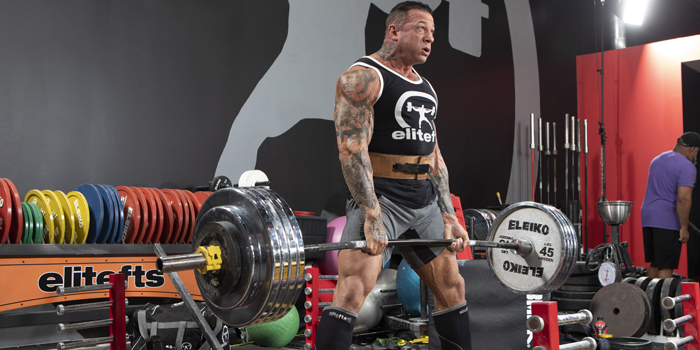
I know, "Here he goes again," but it needs to be said, and it needs to be said frequently: Simple does NOT mean easy. This applies to every person training in a gym, irrespective of their end point goal. Moreso, strength underpins every other bio-motor quality.
So, this means that you must be selective with your movements and train with the movements that allow you to use a decent amount of load. The repetition/intensity relationship range of reps for the development of strength is two to six reps, equating to a percentage of maximum (1RM) of 95% to 80%.
Size Follows Strength
I advocate that size will follow if you train for strength.
The science on hypertrophy also indicates a repetition range of six to 12 reps, equating to a percentage of the maximum range of 80% to 70%. Sets do not necessarily need to be taken to concentric muscular failure every time. Still, each set should be terminated when a technical breakdown occurs to ensure the safety of the person training. There is a crossover range in the middle of these, five to eight reps which seems best to illicit significant increases in strength and size.
I favour a range of sets, reps, and intensity protocols to ensure the training stimulus is optimized for a training week while ensuring recovery between sessions.
Training Time
Remember that the adaptations from the training stimulus occur during the recovery period and are not related to the degree of post-exercise muscle soreness or the "pump." Also, remember that the training time should be no longer than 75 minutes for the development of size and strength since the time course of hormones fits into a specific window of around 45 to 60 minutes. The late genius, Charles Poliquin, had advocated this since the 1980s, so it is not new.
Training Methods
The use of post concentric failure techniques such as forced reps, eccentrics, and isometric holds can be applied judiciously to the more advanced trainee, with at least three years of good heavy and basic training under their belts. Stick to protocols such as Dan John's 8-6-4 for an excellent balance in the strength and size rep zone, or the Rule of 24 system (4 x 6 at 80%, 6 x 4 at 90%, or 8 x 3 at 90+%), or the classic Reg Park/Arnold Schwarzenegger/Bill Starr 5 x 5 (either step loaded or plateau loaded at 85% or more at the size end of the training continuum with 5 x 8 at 70%), or the famous Vince Gironda's 6 x 6 at 75/80%. These are just a few of the methods that I continually use to improve people's training efficiency, irrespective of whether they are athletes or members of the general public.
Rest Periods
Keeping in mind the training window of full hormonal effect (45-75 minutes), and the appropriate rest periods between each set, increased rest time when working at the lower number of reps and decreased rest time working at the higher rep range. This will dictate how many exercises you can perform in a training session and also whether you may be better off splitting the training sessions into other than a full body program.
Exercise Selection
The next step to consider is exercise selection. Compound major movements are the go-to in this process. Learn how to perform them as they are the underpinning foundations of a lifetime of training. Time is undoubtedly the key, and consistently adhering to the principles I have outlined will reap significant results.
What if you just want to lose some fat and look leaner?
The short answer is to re-read the above. You have to stimulate the muscle first and then to drop fat create an environment where caloric expenditure is greater than the calories consumed. Eat less and move more! Circuits and Prowlers® may be your alternate training or a combination of both for a session or two each week and a full body strength/size session on the other one or two days a week.
Now, specifically, which exercises should be performed? Remember in this setting, you are training movements not muscles. Think of yourself as the athletic, not aesthetic. You will achieve all you want without worrying about cable flys and concentration curls.
You cannot carve a spatchcock.
It would be best to have basic movements to load effectively to put meat on your bones. Different trainers call these movement categories different names, so I will try and be as inclusive as possible in the naming of each:
Lower Body Push/Knee Dominant
Squat, Front Squat, Box Squat, Step-ups, Lunge (multitude of bar variations), Single-Leg Squat Variations, Belt Squats
Lower Body Pull/Hip Dominant
Deadlift, Good Morning, Trap Bar Deadlift, Romanian Deadlift, Hip Thrusts, Glut ham raise, Reverse Hyper®
Upper Body Push
Horizontal – Bench Press, Incline Bench Press (Bar or DB's), Close Grip Bench Press, Floor Press, Dips
Vertical – Military Press, Press Behind Neck, DB Shoulder Press
Upper Body Pull
Horizontal – Bench Pull, Seated Row, DB Row, Bent-over Row (traditional, Pendlay, Yates)
Vertical – Chin-up, Pull-up, Pulldown, Shrugs, High Pulls (Snatch & Clean grip)
Arms
Biceps – EZ bar Curls, DB Twist Curls, Hammer Curls
Triceps – JM Press (Swiss or traditional bar), Dips, Floor Press, Close Grip Bench Press
So, now to look at a training week as a four-day split and a three-day full body.
4-Day
| Lower | Upper | Lower | Upper |
| Box Squat with Cambered Bar 5 x 5 | Incline Bench Press 8, 6, 4 | Deadlift 4 x 6 | Military Press 5 x 8 |
| Romanian Deadlift 5 x 8 | Yates Row 4 x 6 | Belt Squat 5 x 8 | Pull-up 5 x 8 |
| Walking Lunges 4 x 25 yards | DB Shoulder Press 5 x 8 | Glute Ham Raise 8, 6, 4 | Close Grip Bench Press 8, 6, 4 |
| Hip Thrusts 5 x 8 | Chin-ups 4 x 6 | Bulgarian Sprinter’s Squat 5 x 8 each leg | Seated Row 4 x 6 |
| DB Twist Curls 3 x 12 | EZ Bar Curls 4 x 6 | ||
| Close Grip Bench Press 8, 6, 4 | JM Press with Swiss Bar 8, 6, 4, 4 | ||
| CARE Lower + Core | CARE Upper + Neck | CARE Lower + Core | CARE Upper + Neck |
3-Day
| Monday (all 8, 6, 4) | Wednesday (all 4 x 6) | Friday (all 8, 6, 4) |
| Front Squat | Cambered Bar Box Squat | Safety Bar Squat |
| Trap Bar Deadlift | Glute Ham Raise | Romanian Deadlift |
| Bench Press | Military Press | Incline Bench Press |
| Bent-over Row | Pulldowns | Seated Row |
| EZ Bar Curls | Hammer Curls with Swiss Bar | Chin-ups |
| JM Press with Swiss Bar | Close Grip Bench Press | Dips |
| CARE program | CARE Program | CARE Program |
Core Accessory Rehab Exercise Program (CARE)
Choose five (5) of the following options
2 x 10 reps on each
- Core: ½ Turkish Get-up, Windmills, Rollouts, Suitcase Deadlift, Combat Twist, Weighted Sit-up, TRX Leaning Pallov Press to Overhead Position
- Grip: Grippers, Chin-up Variations (rope, grandfather clock, grenades, pinch grip)
- Lower Body: Copenhagen Plank, Crab Walk with Band, Lateral Lunge, Nordics, Swiss Ball Leg Curl, Banded Leg Curl, Hip Thrusts, Calf Raise, Petersen Step-ups
- Shoulder/Rotator Cuff: Incline YTI's, Bottom-up KB Press, Cuban Press, DB Scarecrow, Plate Bus Driver
- Neck: Rotary Neck, Wrestler's Bridge 2-ways, Neck Planks 3-ways, Band Look Away, 4-way Neck.
There you have it. Just because it's a simple program, never underestimate its worth.
Simplicity plus intensity are the keys to stimulate, recover, and grow. (Repeat).
Ashley Jones has worked in three professional sports across 30 years and four continents. He was awarded the NSCA's Professional Coach of the Year in 2016. Ashley holds his CSCS (Certified Strength and Conditioning Specialist) since 1988 and is an honorary lecturer in the School of Therapeutic Sciences, University of Witwatersrand, Johannesburg, SA.











Looking forward to meeting you in person at the SWIS!!
Great article
How long would you stay on this program?
For example would 6 weeks be about right, and how would you progress from week to week, just adding weight to the bar?
Cheers